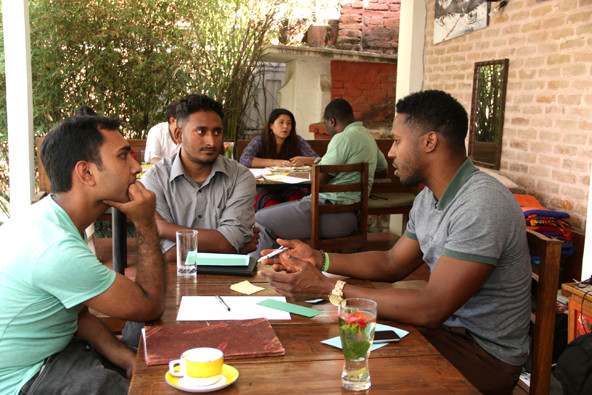 Effective board training goes beyond the boardroom during a site visit to Nepal. (Image courtesy of Echoing Green)
Effective board training goes beyond the boardroom during a site visit to Nepal. (Image courtesy of Echoing Green)
Only 20 percent of nonprofit board members in the United States are people of color. Twenty-five percent of boards are entirely comprised of white people, and 90 percent of board chairs are white. What’s more, 89 percent of nonprofit CEOs are white. This is a big problem, because diversity matters; there’s a causal relationship between diversity and groups that are more innovative, creative, problem-solving, and better performing overall. If we want to optimize the social sector’s potential to create impact, diverse nonprofit boards are not a “nice to have,” they are a “must have.”
The good news is that nearly 70 percent of board members are not satisfied with the racial and ethnic diversity on their board, which indicates there exists a desire to carve a different path forward. And creating more diverse, inclusive, and equitable boards does not need to be a complicated endeavor.
As the leader of Direct Impact, Echoing Green’s board leadership program, my goal is to prepare the next generation of board members through an experiential program that goes beyond classroom training and is grounded in the idea that we can fundamentally shift the role that boards play in solving social problems. And to my mind, developing a diverse, inclusive, and equitable board comes down to a simple notion, said best by Yoda: “Do or not do. There is no try.”
Make the decision
Are you enjoying this article? Read more like this, plus SSIR's full archive of content, when you subscribe.
It’s hard to fix problems we do not name. So to start the process, nonprofit boards and CEOs must make an internal and external commitment to this work. Yes, going public with this goal may bring unwanted attention to current challenges with diversity, equity, and inclusion. But doing so will also help encourage peers to join the effort and shine light on what can be.
(It may help you to know that CEOs in the private sector are doing the same thing. As a critical mass of organizations working on transforming their boards develops, we can all begin to hold each other more accountable.)
As part and parcel of making the decision, board chairs and CEOs should commit to taking the following baseline steps:
- Create a clear board member role description that outlines expectations, roles and responsibilities, fundraising requirements, and your organizational values. In your description, communicate your organization’s commitment to diversity, equity, and inclusion.
- Recruit better, and reach beyond the immediate network. Board members are often recruited through personal connections, which are not typically diverse. Who are your partners? Who is engaged with your communities? And where do you not know to look? Post your search publicly and broadly to increase the pool of board prospects.
- Develop a strong vetting process. Each board member should go through the same process to ensure equitable evaluation. The process should include interviews with staff, board members, and other stakeholders.
Build an infrastructure that supports equity
While the description of the role will outline requirements for service, do not let it get in the way of making fair exceptions. Fundraising capacity should not be a sole criterion for board membership. Consider: Someone who is deeply connected with your community can bring immense value to the organization by developing new relationships and growing existing ones.
Building an infrastructure—in the form of thoughtful and clearly articulated policies and processes that guide board responsibilities, expectations, accountability, and behaviors—helps to diminish power dynamics that can exist in any boardroom. Without such an infrastructure, it can become easy to perpetuate the systems that are in place, and you may find that your biggest fundraisers de-facto have the most power—a situation that is not conducive to equity.
To build an effective infrastructure:
- Create a board evaluation and accountability process. Board members are volunteers, but they still require, and appreciate, opportunities to measure their success. A consistent board evaluation process allows the board to track its own success, get feedback on areas of strength as well as areas that need improvement, and optimize peer accountability.
- Set up a board-meeting structure that is conducive to productive conversation. Begin with a “relationship-building moment” that allows board members to interact with each other on a personal level. Then move into big strategic discussions. Finish with updates and approval of meeting minutes.
- Create equitable standards for participation. Most boards have a fundraising requirement, yet few nonprofits train board members on fundraising. Consider doing so. Also, offer different ways for members to contribute. For example, work with board members individually to set fundraising goals or find alternate ways to participate if fundraising presents a major challenge. I frequently work with Echoing Green Fellows who want to include community members on their boards, and my response is always a resounding: “Yes, you must!” We then think through ways to ensure that their commitment and input, whether or not financial, is captured and clear to the board on the whole.
Don’t forget: inclusion starts with leadership
 Direct Impact board training in the field during an immersive learning trip to Rwanda. (Photo courtesy of Echoing Green)
Direct Impact board training in the field during an immersive learning trip to Rwanda. (Photo courtesy of Echoing Green)
Few board members have received formal board training, and when they have, it is typically focused on the financial and legal requirements of the role. While these are important, a board’s productivity is ultimately grounded in teamwork, strategic discussions, and shared decision-making and communication structures.
To that end:
- Build trust and relationships deliberately. Some board members may inherently trust each other, while others may not. Providing frequent opportunities for board members to get to know one another, inside and outside the board room, can support relationship-building and trust.
- Coach the board on group dynamics. Everyone shows up with assumptions and implicit biases, which can be detrimental to healthy debate. To foster better conversations, share frameworks such as “appreciative Inquiry” and encourage the use of tools such as “implicit association tests.”
- Get comfortable being uncomfortable. Doing the work to build a diverse, equitable, and inclusive board can mean having some tough conversations. Make sure your board members acknowledge this reality, and can lean into the growing pains and challenges that come with change.
High-impact boards operate to their fullest potential when they tap into a diversity of thought—by drawing from the expertise of people across race, ethnicity, sexual orientation, and other dimensions such as professional experience, age, and so on. An exceptional board is a high-performing team with a shared purpose to drive the work of the organization forward toward an important vision. Fostering a space where the experiences of a diverse group are valued and applied to the oversight of social impact organizations is important to addressing social challenges.
This roadmap is not exhaustive of all of the opportunities, but as social sector leaders, we must start somewhere and share our successes and challenges in this process as we work toward creating a stronger and more effective board ecosystem. Do or not do. Let’s get started.
Support SSIR’s coverage of cross-sector solutions to global challenges.
Help us further the reach of innovative ideas. Donate today.
Read more stories by Kate Hayes.

